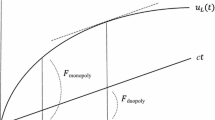Abstract
The behavioral assumptions for welfare analysis of self-selecting tariffs are generalized to be consistent with those maintained in empirical models of tariff choice. When customers have pure preferences among tariffs, it is shown that the optimal self-selecting tariffs provide strictly greater welfare than mandatory marginal cost prices, contain marginal prices that do not equal marginal cost, and can Pareto dominate an existing tariff. As an illustration of the theoretical results, optimal self-selecting tariffs are calculated empirically for a local telephone company.
Similar content being viewed by others
References
Baumol, W., and D. Bradford, 1970. “Optimal Departures from Marginal Cost Pricing,”American Economic Review 67(3): 350–365.
Brown, G. and D. Sibley, 1986.The Theory of Public Utility Pricing, Cambridge University Press.
Coase, R., 1946. “The Marginal Cost Controversy,”Economica 13: 169–189.
Faulhaber, G., and Panzar, J., 1977. “Optional Two-Part Tariffs with Self-Selection,” Bell Laboratories Economic Discussion Paper No. 74.
Hausman, J. and D. Wise, 1978. “A Conditional Probit Model for Qualitative Choice: Discrete Decisions Recognizing Interdependence and Heterogenous Preferences,”Econometrica. 48(2): 403–426.
Hobson, M. and R. Spady, 1987. “Demand for Local Telephone Service Under Optional Local Measured Service,” technical memorandum Bell Communications Research.
Kling, J., 1984. “Estimation of Local Exchange Elasticities,” report, Michigan Bell Telephone Company.
Kling, J. and S. van der Ploeg, 1988. “Estimating Local Telephone Call Elasticities with a Stochastic Model of Class of Service and Usage Choice,” paper presented at the Seventh International Conference of the International Telecommunications Society, MIT.
Leland, H. and R. Meyer, 1976, “Monopoly Pricing Structure with Imperfect Discrimination,”Bell Journal of Economics 7: 449–462.
Littlechild, S., 1975, “Two Part Tariffs and Consumption Externalities,”Bell Journal of Economics 6: 661–670.
Luce, R., 1959.Individual Choice Behavior, New York: Wiley.
MacKie-Mason, J., 1990. “Optional Time-of-Use Pricing Can Be Pareto Superior or Pareto Inferior,”Economic Letters, 33: 363–367.
Marschak, J., 1960. “Binary Choice Constraints on Random Utility Indicators,” in K. Arrow, ed.,Stanford Symposium on Mathematical Methods in the Social Sciences, Stanford University Press.
McFadden, D., 1973. “Conditional Logit Analysis of Qualitative Choice behavior,” in P. Zarembka, ed.,Frontiers in Econometrics, New York: Academic Press.
McFadden, D., 1981. “Econometric Model of Probabilistic Choice,” in Manski and McFadden, eds.,Structural Analysis of Discrete Data with Econometric Applications, MIT Press.
McFadden, D., 1987. “Regression-Based Specification Tests for the Multinomial Logit Model,”Journal of Econometrics 34: 63–82.
McFadden, D., K. Train, and W. Tye, 1977. “An Application of Diagnostic Tests for the Independence from Irrelevant Alternatives Property of the Multinomial Logit Model,”Transportation Research Record 637: 39–46.
Ng, Y. and M. Weissner, 1974. “Optimal Pricing with a Budget Constraint: The Case of the Two-Part Tariff,”Review of Economic Studies 41.
Panzar, J., 1977. “The Pareto Domination of Usage-Insensitive Pricing,” in H. Dorrick, ed.,Proceedings of the Sixth Annual Telecommunications Policy Research Conference, Lexington, MA: Lexington Books.
Small, K., and H. Rosen, 1981. “Applied Welfare Economics with Discrete Choice Models,”Econometrica 49: 105–130.
Tardiff, T., 1989. “Consumer Welfare with Discrete Choice Models: Implications for Flat versus Measured Local Telephone Service,” report, National Economic Research Associates.
Thurstone, L., 1927. “A Law of Comparative Judgment,”Psychology Review 34: 273–286.
Train, K., 1986.Qualitative Choice Analysis, MIT Press.
Train, K., D. McFadden, and M. Ben-Akiva, 1987. “The Demand for Local Telephone Service: A Fully Discrete Model of Residential Calling Patterns and Service Choice,”Rand Journal of Economics 18(1): 109–123.
Train, K., M. Ben-Akiva, and T. Atherton, 1989. “Consumption Patterns and Self-Selecting Tariffs,”Review of Economics and Statistics 71: 62–73.
Train, K., and G. Mehrez, 1994. “Optional Time-of-Use Prices for Electricity: Econometric Analysis of Surplus and Pareto Impacts.”Rand Journal of Economics 25 (No. 2, forthcoming).
Willig, R., 1978. “Pareto Superior Non-Linear Outlay Schedules,”Bell Journal of Economics 9:56–69.
Wilson, R., 1991.Nonlinear Pricing, Oxford University Press.
Author information
Authors and Affiliations
Rights and permissions
About this article
Cite this article
Train, K.E. Self-selecting tariffs under pure preferences among tariffs. J Regul Econ 6, 247–264 (1994). https://doi.org/10.1007/BF01064654
Issue Date:
DOI: https://doi.org/10.1007/BF01064654




